Solanum lycopersicum ‘Roma’
The quintessential plum tomato, ‘Roma’ is prized for its tangy, rich taste and dense-walled, meaty flesh.
As low-moisture paste tomatoes, their flavor intensifies with heat, making them a top choice for cooking. The dense, gel-less texture holds up magnificently on the grill, sun-dried, or roasted.
Along with the fantastic taste, texture, and low moisture, they have few seeds – all of which make them highly popular with the canning crowd.
They are the perfect tomatoes for creating zesty ketchups, salsas, sauces, pastes, purees, and relish.
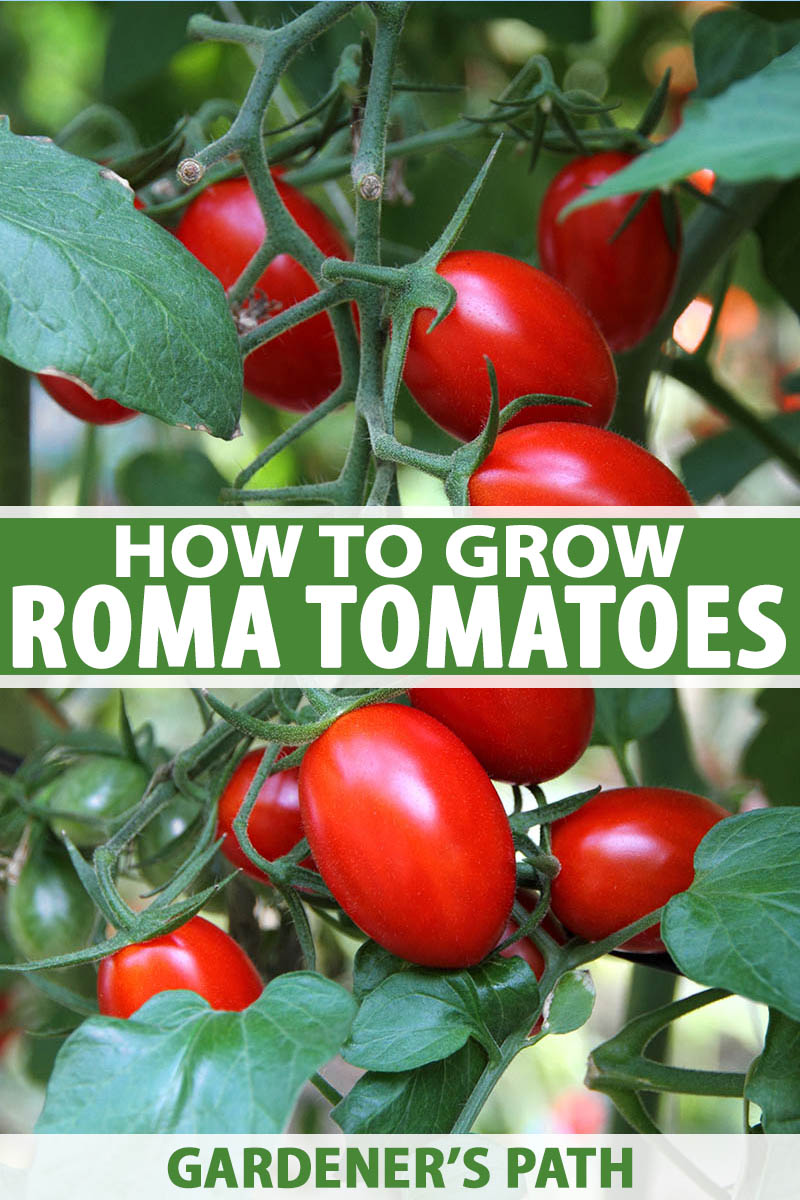
We link to vendors to help you find relevant products. If you buy from one of our links, we may earn a commission.
And with their rich flavor and drip-free texture, Roma tomatoes are also ideal for eating fresh. They’re delicious chopped up on bruschetta or in salsa, and sliced for sandwiches and salads.
Or simply toss them with fresh basil and olive oil.
Plus, the fruit freezes well for a tasty addition to sauces, soups, and stews throughout the year.
Romas grow on vigorous plants with a heavy yield and thrive in sunny raised beds, containers, and vegetable plots.
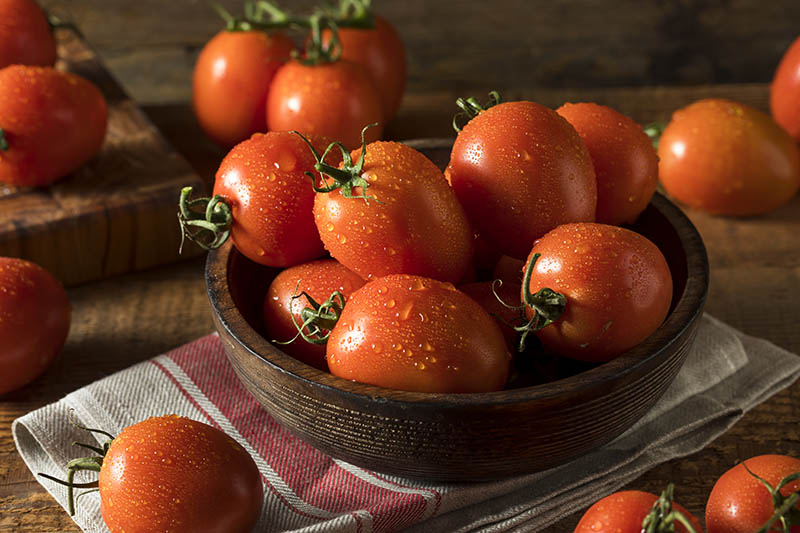
Fast-growing and easy to cultivate, you won’t want to miss out on adding these tasty and versatile plants to your own garden.
Here’s what I’ll cover:
What You’ll Learn
What Are Roma Tomatoes?
Although distinctly Italian sounding, ‘Roma’ is actually an American hybrid.
We can thank the USDA’s Agricultural Research Service for creating the first ‘Roma’ tomato hybrid in 1955.
But it does have Italian parentage, being a cross of the famous and flavorful ‘San Marzano’ – an open-pollinated heirloom cultivar native to the volcanic soil in the region around Mount Vesuvius – and ‘Pan America.’
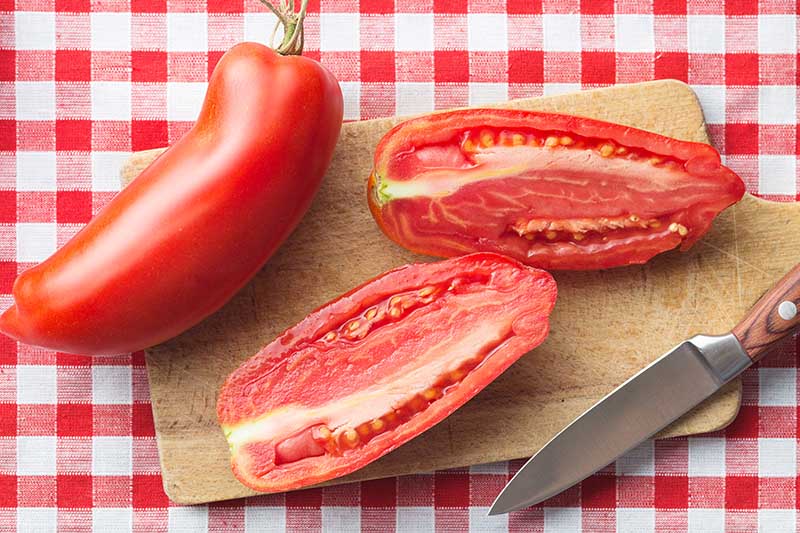
You may see ‘Roma’ referred to as Italian or Italian plum tomato, and the name is commonly used as a generic term to describe a paste tomato.
An early variety, ‘Roma VF,’ was bred in 1963 for its resistance to both verticillium and fusarium wilt.
As a result, most cultivars – including those now classified as heirlooms – have the same resistance, thanks to this early breeding.
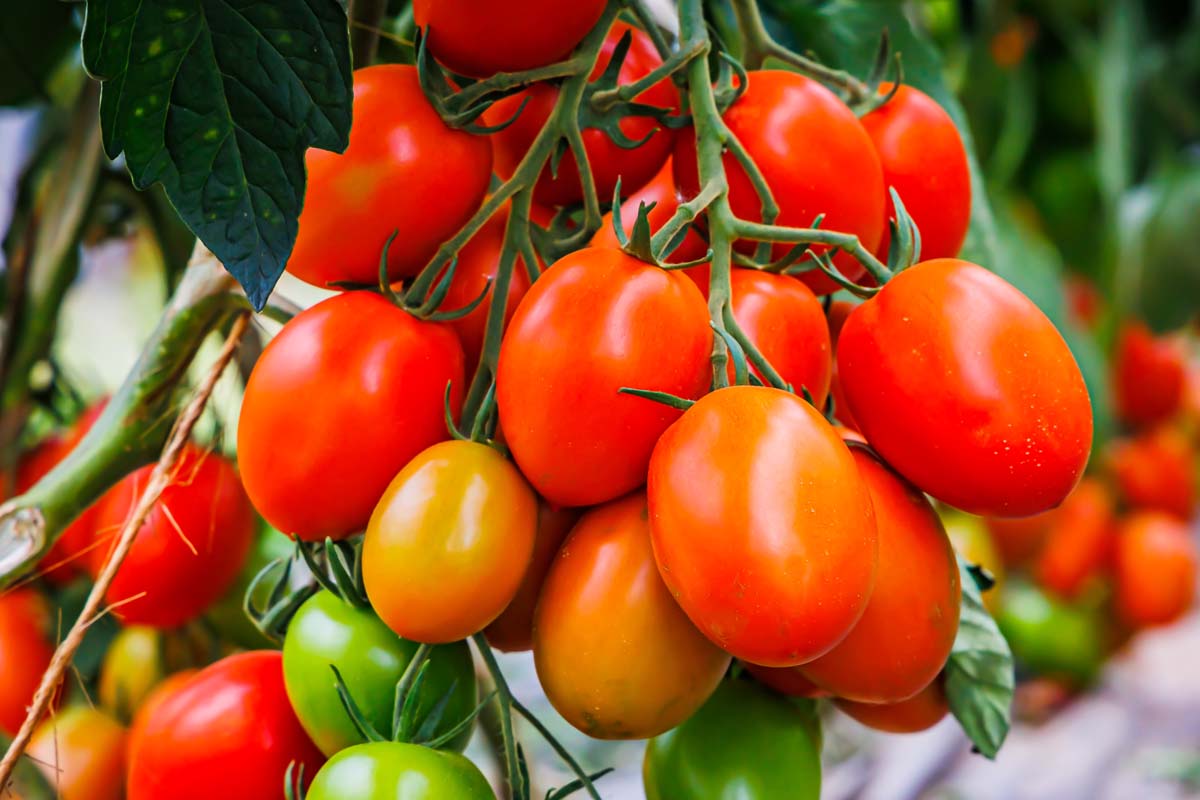
The bright red, rose, or yellow fruits are oblong, with an egg or pear shape, and typically measure two to four inches long.
Plants can be determinate or indeterminate and produce ample clusters of fruit that may require cages, stakes, or trellises to provide support for heavily laden branches.
When eaten fresh, these tomatoes have complex flavors that are both sweet and tangy.
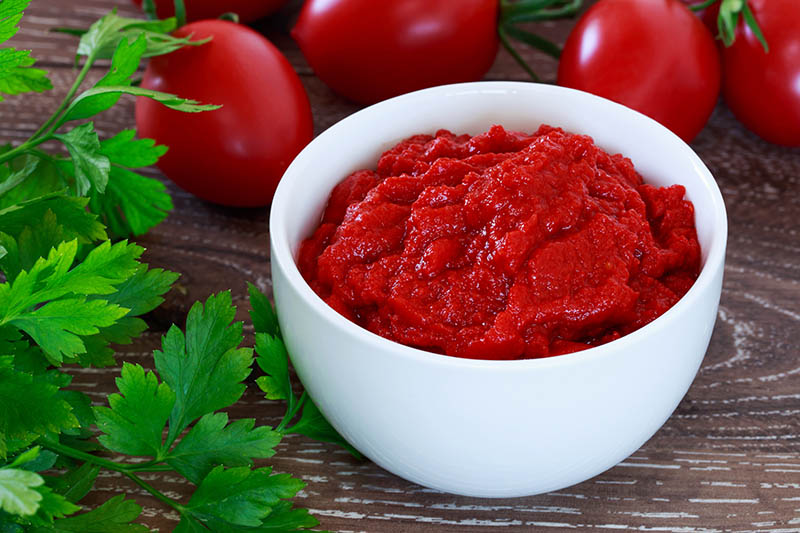
But the fullest flavors emerge with cooking, where they deepen and intensify – they’re perfect on the grill, roasted, or slow cooked.
Starting from Seed
All tomatoes need a long growing season. Seeds are best started indoors six to eight weeks before the last frost date for your region.
If you’re new to seed propagation, our guide has all the details you need on how to grow tomatoes from seed in six easy steps.
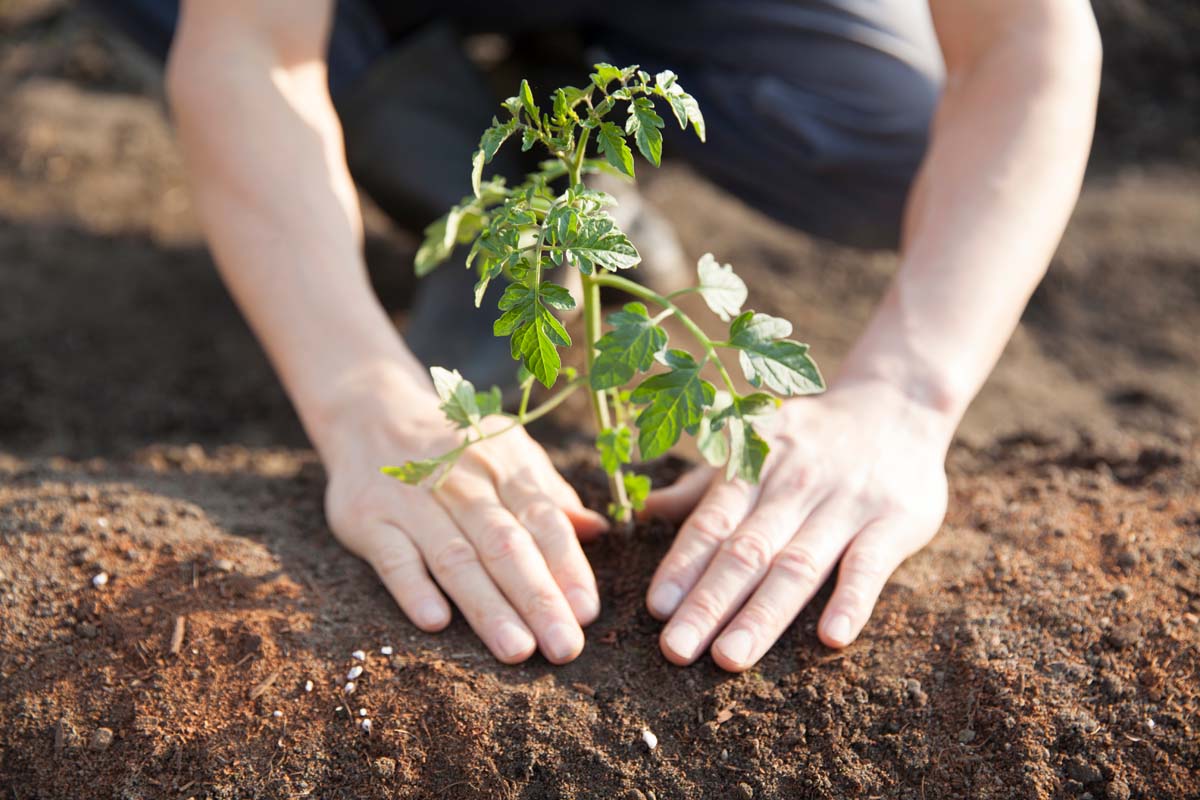
Once seedlings grow to about six inches tall, you can begin to harden them off in preparation for planting outdoors.
Or if you prefer, wait until your local garden center is stocked with seedlings to choose from.
How to Plant Roma Tomatoes
Romas are naturally robust and hearty plants, but there are a few things that will help ensure a bumper harvest!
When to Plant
Before you set out your transplants, you’ll want to make sure that you are well past your last frost date. Cold weather can severely damage or even kill your plants.
Harden off seedlings gradually, and only transplant outdoors when nighttime temperatures no longer drop below 50°F.
Use a cloche or plant cover if cold, wet, or windy conditions set in.
Where to Plant
Choosing the right planting site is critical for optimal growth and high yields.
These sturdy plants thrive in warm climates and require plenty of light, so be sure to select a location that receives at least six, preferably eight hours of direct sunlight each day.
Roma tomatoes require well-drained loamy soil with a pH level between 6.2 and 6.5, so check your soil’s pH and amend as needed.
If your soil is too acidic (lower in pH), consider adding lime to reduce the acidity. You may wish to mix in some organic matter such as compost or well-aged manure to boost fertility.

Be mindful that these plants grow quite tall, so incorporate that into your garden design.
Grow understory veggies such as lettuce and spinach that enjoy a respite from the hot sun. You may be able to get a couple more weeks out of these lower growing plants that prefer cooler weather.
Proper drainage is essential for Roma tomato plants, so avoid planting them in areas that are prone to standing water or heavy rainfall.
For planting, you can choose raised beds, garden beds, or containers, depending on the space available and your preference.
At planting time, pinch off the lowest two sets of branches and bury the stem close to the lowest remaining branches. This helps to promote more root growth.
Adding lime or Epsom salts to the planting hole helps with calcium uptake and aids in the prevention of future problems like blossom end rot.
Spacing Requirements and Support
Most Roma plants are determinate which means that the fruits arrive pretty much all at once.
There are also indeterminate cultivars available that continue to flower and set fruit throughout the growing season. See our guide on determinate vs indeterminate for more info.
You’ll want to know what your particular plants are in order to determine the spacing requirements.
Plant determinate varieties 12 to 24 inches apart in rows four feet apart. Indeterminate varieties often grow much larger and usually need two to three feet between plants with row spacing up to six feet.
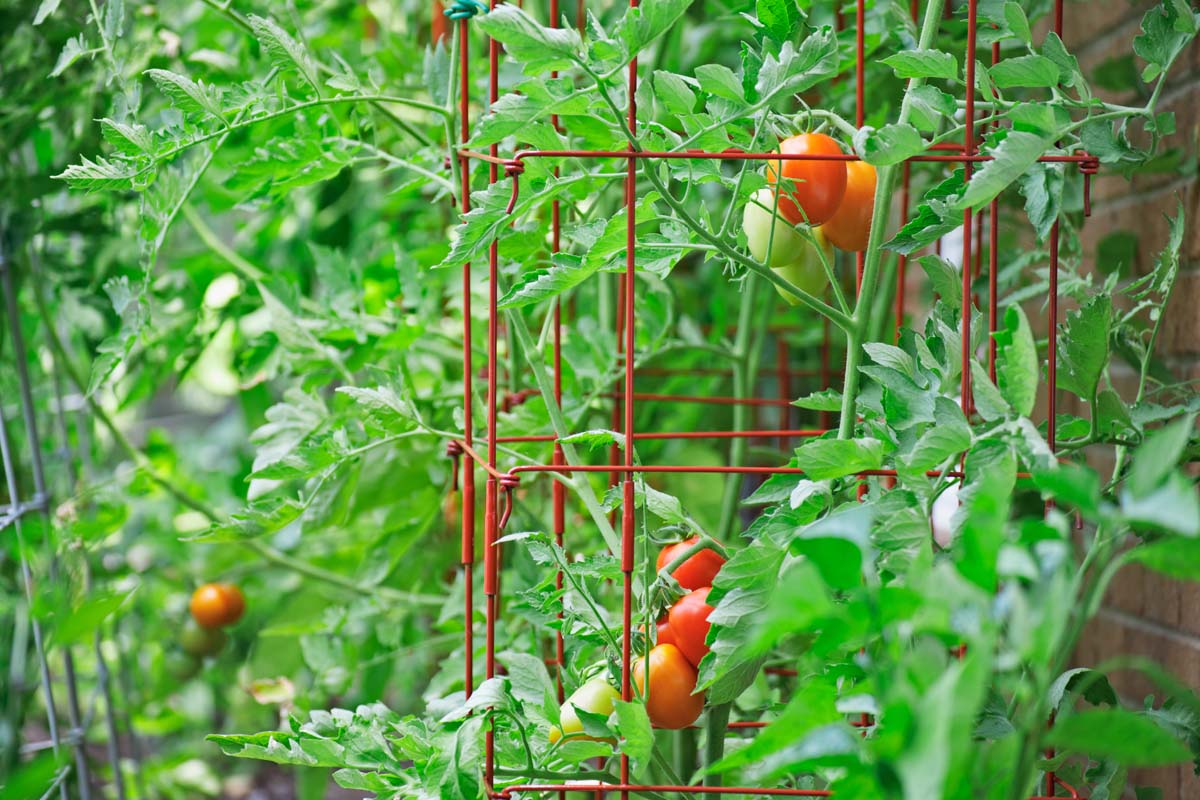
Which plant that you’ll want to grow depends on your needs.
If you prefer fruit for fresh eating, indeterminate varieties will spread out your harvest throughout the season. If your are canning your produce, you may want it to arrive all at once – or perhaps not if you spread your canning efforts through the summer.
Install cages or stakes for support to prevent root disturbance later on. You may also choose to use a low budget approach such as the “florida weave” to support your tomato plants.
Growing in Containers
Roma tomato plants do quite well in when grown in pots or even five gallon buckets.
Use a loose potting mix enriched with organic materials like compost or aged manure and amended with water-retaining materials such as coconut coir, peat moss, or vermiculite.
Container plants typically require more frequent feeding and can be given a half-strength solution of fertilizer every week if needed.
Pot-grown plants often need more frequent watering as well. When the top inch of soil is dry, water slowly and deeply. This allows the soil to absorb the moisture and not flood out the drainage holes.
Our guide to growing tomatoes in containers will cover specifics suited to that method, for patio growers and other small space gardeners.
Roma Tomato Plant Care
Roma tomato care requirements are similar to that of other tomato plants.
To prevent problems like blossom end rot, split skins, and catfacing, water plants deeply once a week instead of providing more frequent shallow watering.
The entire root ball, including the lowest roots, need to have a drink – not just the surface ones.
To help retain moisture and keep weeds down, add a natural mulch of grass clippings, leaf mold, or straw.
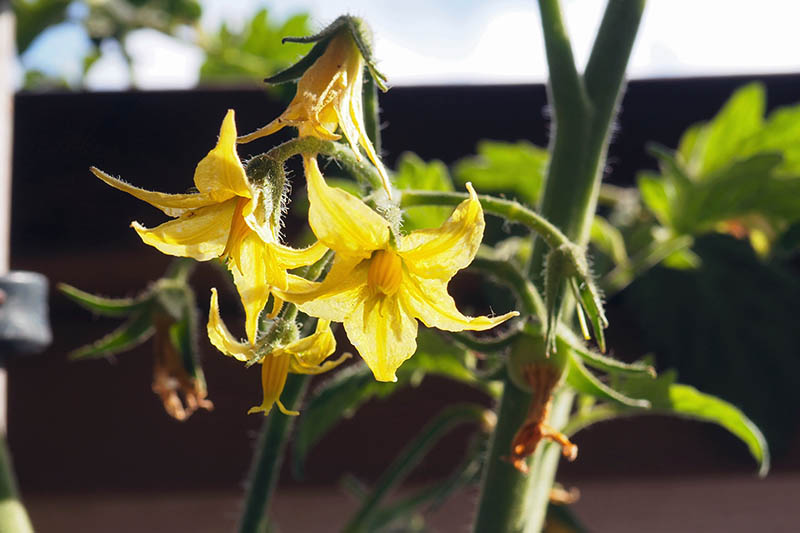
Pinch out suckers as they appear. Suckers are the small secondary branches that appear in the “V” between main branches and the stem. Removing them directs energy into fruit production.
Once flowers begin to set, feed every two weeks with a balanced fertilizer, or use a tomato formula of 18-18-21 (NPK).
Fruits typically ripen in 70 to 80 days.
Cultivars to Select
For fresh eating or to put up preserves, there are several outstanding varieties for your consideration.
You can find seeds for the classic heirloom ‘Roma’ cultivar available at Eden Brothers.
Or if you want to try something a little bit different, here are a few of the most popular cultivars:
Cherry Roma (Heirloom)
A mini cultivar, ‘Cherry Roma’ produces an abundance of small one-ounce fruits with an intense, fresh flavor that’s both sweet and tangy.
Ideal for an instant snack, the firm fruit is perfect to chop up for bruschetta or tossed into a salad with fresh basil.
The indeterminate plants grow 36 to 40 inches and fruits mature in 75 to 80 days.
Seed packets are available at Burpee.
La Roma III (Hybrid)
This hybrid cultivar produces a large crop of five-ounce, bright red fruits on vigorous, determinate vines.
Firm-fleshed and tasty, they are perfect for canning, sauces, and paste.
Highly disease resistant, these vigorous plants will require caging or other support.
You can find seeds available at True Leaf Market.
Orange Roma (Heirloom)
With a rich, sweet flavor and orange skin and flesh, these two-ounce fruits grow abundantly on vigorous, indeterminate vines.
They’re ideal for adding a splash of color to summer salads, and the firm flesh is perfect for salsa and sauce.
Fruits mature in 75 days.
You can find packets of seeds in a variety of sizes available at Eden Brothers.
Roma Grande (Hybrid)
These vigorous plants are one of the best for extreme temperatures, both hot and cold.
‘Roma Grande’ (aka ‘Rio Grande’) features an abundance of bright red pear-shaped fruits with a full flavor that’s both acidic and sweet.
The four-ounce fruits are firm and meaty, ideal for juicing, paste, and sauces.
The determinate plants grow 15 to 24 inches and are very productive. Caging is recommended to support vines laden with fruit.
Fruits ripen in 75 to 85 days and plants are heavily disease resistant.
Seeds are available at Burpee.
Roma VF (Heirloom)
The first cultivar, ‘Roma VF’ is a vigorous plant with abundant yields of bright red and mild tasting two-ounce fruits.
An excellent variety for ketchup, puree, and sauces, the determinate vines grow 30 to 36 inches and fruit matures in 76 days.
Plants are resistant to verticillium wilt and fusarium wilt.
Seeds are available at True Leaf Market.
Yellow Roma
Golden-yellow fruits add a punch of color to the garden – and the salad bowl.
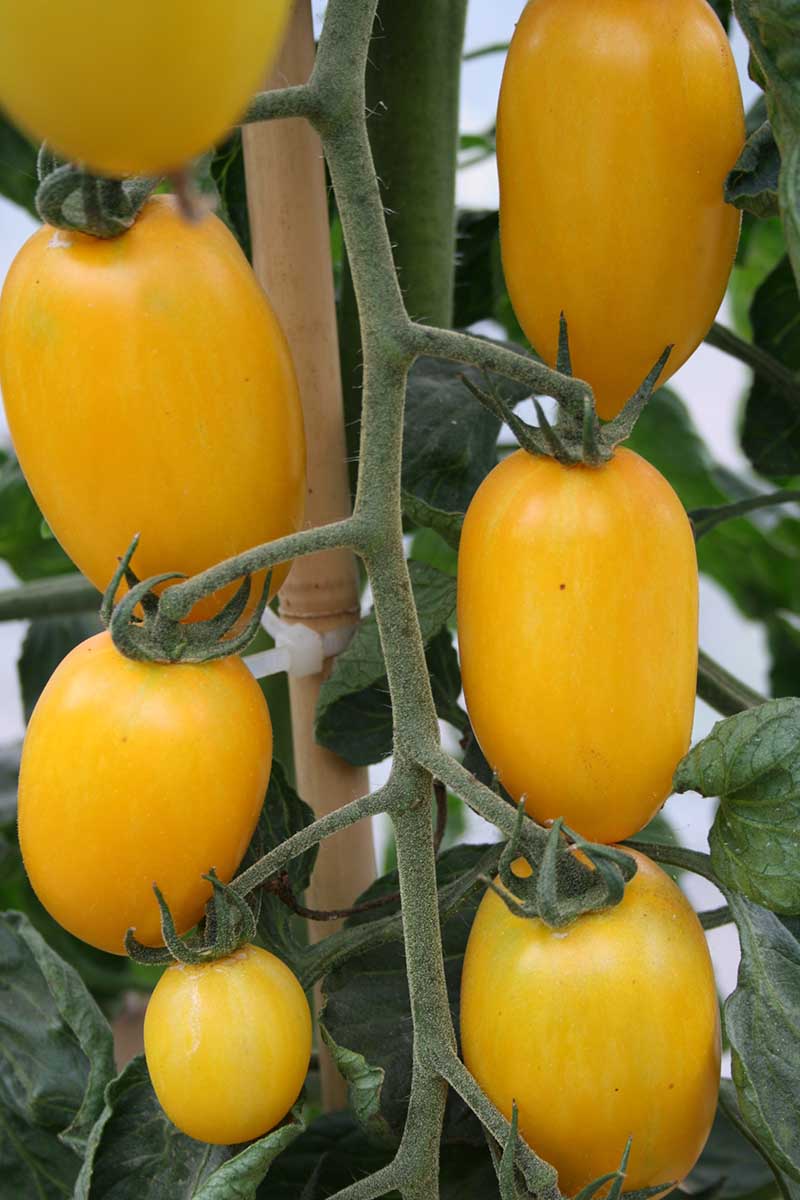
Firm flesh with a low acid and sugar content has a subtly sweet flavor that is enhanced by cooking.
Determinate vines produce an abundance of one to two-ounce fruits, and grow to a mature size of 40 inches.
Managing Pests and Diseases
Romas are susceptible to most of the same pests and diseases that affect all tomato plants.
Some common pests include:
- Aphids
- Mockingbirds and Blackbirds
- Slugs
- Squirrels
- Stink Bugs
- Tomato Hornworms
Some common diseases include:
- Anthracnose
- Blossom-End Rot
- Fusarium Wilt
- Powdery Mildew
- Various Blights
- Verticillium Wilt
We have a comprehensive list of diseases that affect tomatoes here.
Harvesting Roma Tomatoes
The best time to harvest is when the fruit is fully colored and slightly soft to the touch. Signs that a Roma tomato is ready for picking include a vibrant red color and a slight give when gently squeezed.
When picking Roma tomatoes, it’s important to use the right technique. Hold the fruit in one hand and the stem in the other, then gently twist and pull to remove the tomato from the vine.
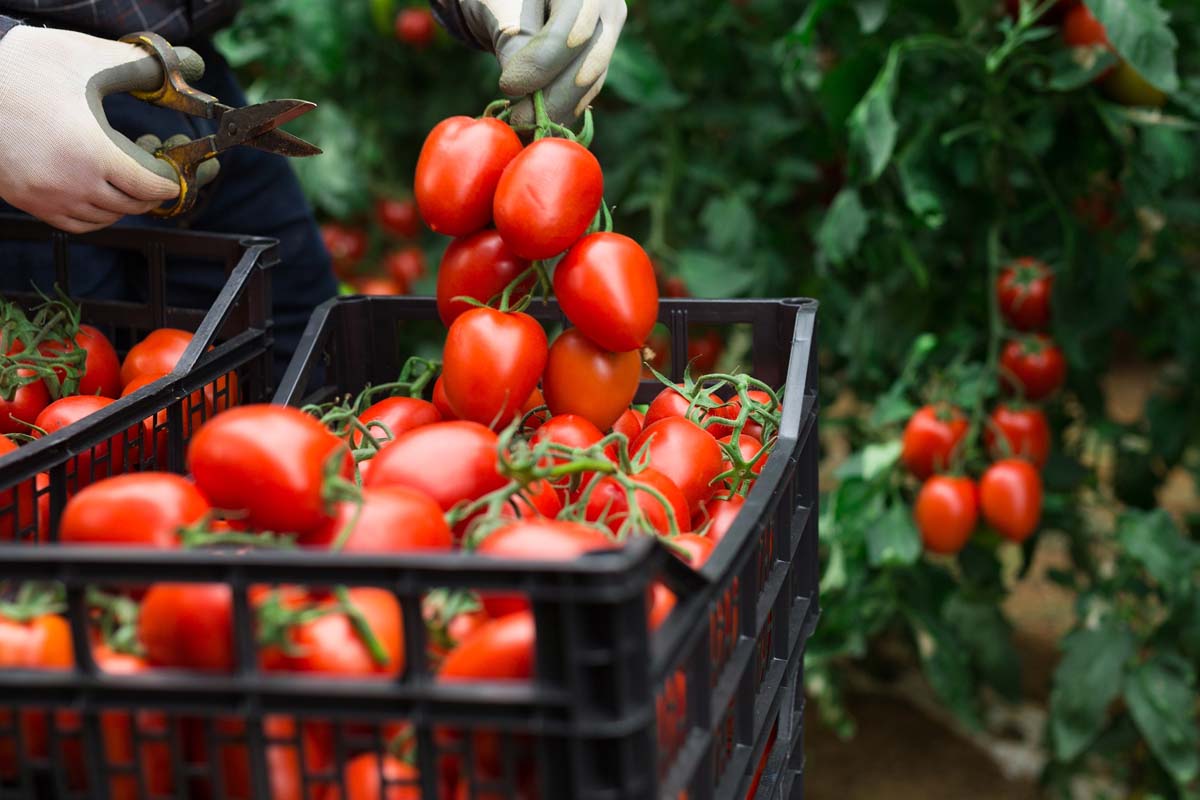
Alternatively, you can cut the stem with your shears or knife to harvest individual fruits or remove the entire vine. Be gentle to avoid bruising the fruit, as this can lead to spoilage.
Once you’ve harvested your Romas, the next step is to clean them. Remove any debris and dirt by lightly brushing the tomatoes or washing them under cool, running water. Dry them thoroughly to prevent mold and bacteria from developing.
It’s okay if you harvest some green ones, you can make them turn red by leaving them in a warmer area such as a picnic table or on a window sill.
Storing
Storing Roma tomatoes is simple.
Place your tomatoes in a single layer in a tray or shallow bowl, with the stem end facing up to reduce the risk of bruising.

For fresh eating, they should ideally be kept at room temperature, away from direct sunlight. Avoid refrigerating them, as this can affect their flavor and texture.
However, for longer term storage, refrigeration will extend their life. But for optimal flavor, allow them to come up to room temperature before consuming.
Regularly inspect your stored tomatoes for signs of spoilage, such as mold, soft spots, or an off smell. If you spot any of these signs, discard the affected tomatoes immediately to prevent the spread of spoilage.
Find more tips in our guide to storing tomatoes.
Preserving
If you have a large harvest and want to preserve your Roma tomatoes for long-term use, there are several methods you can use.
Canning is a popular option, allowing you to enjoy your tomatoes year-round.
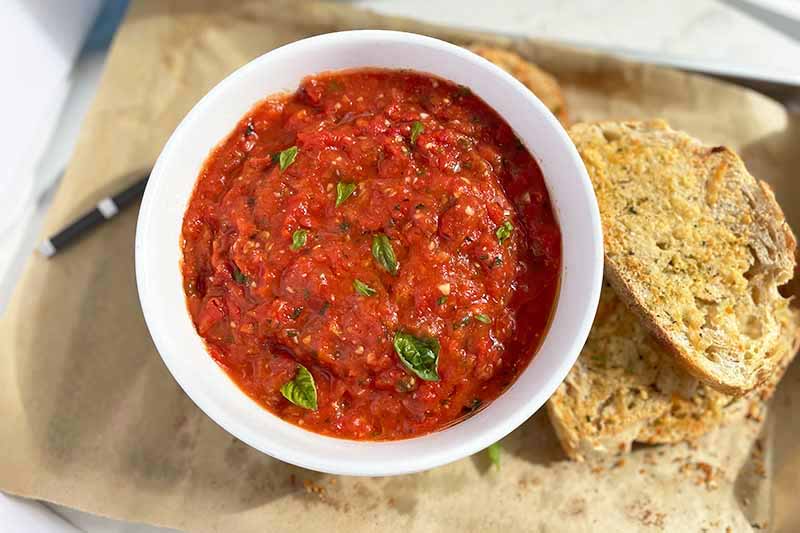
Freezing is another simple and effective method, particularly if you’ll be using your tomatoes in cooked dishes. Read more about freezing tomatoes.
Lastly, drying your tomatoes can concentrate their flavor and make them a delicious addition to a variety of dishes. Read more about dehydrating tomatoes.
Each preservation method has its own set of instructions, so be sure to research the best practices for each one. Happy harvesting!
Roma Tomato Recipe Ideas
Cooking really brings out the rich, complex flavors of ‘Roma’ tomatoes, and they make a great addition to many recipes.
Here are a few ideas to try out this summer.

You can’t go wrong with bruschetta.
For a balanced flavor and great texture, try your freshly harvested ‘Roma’ in this sumptuous homemade tomato basil bruschetta – you can find the recipe at Foodal.
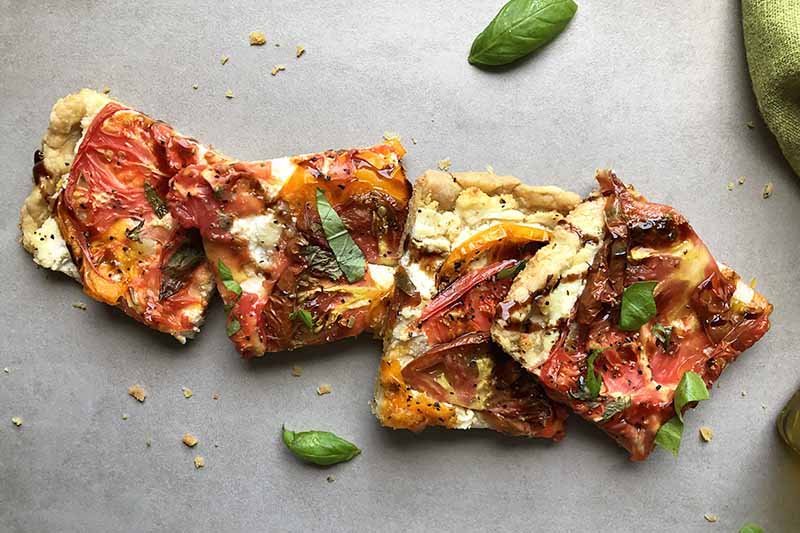
For a zesty appetizer or entree, this einkorn pastry with tomato, ricotta, and basil is ideal for a rich, delicious flavor your guests will love. The recipe’s at Foodal.
And for those who like a relish with a tangy bite, try them in a sweet and savory tomato jam.
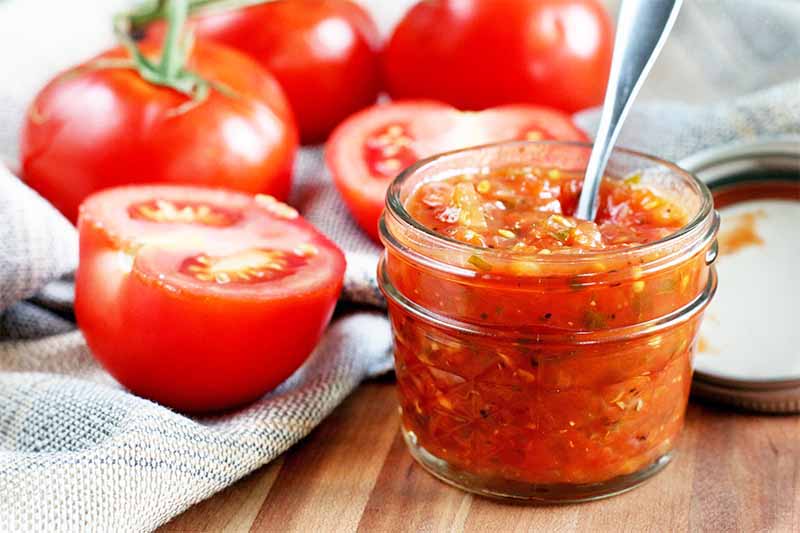
I love their rich taste and always add in a big handful of fresh basil and parsley along with some diced and sauteed celery and onion.
You can find this zesty recipe at Foodal as well.
Quick Reference Growing Guide
| Plant Type: | Annual vegetable | Water Needs: | High |
| Native to: | America | Maintenance: | Moderate |
| Hardiness (USDA Zone): | 3-11 | Tolerance: | Heat |
| Season: | Summer | Soil Type: | Organically rich, fertile |
| Exposure: | Full sun | Soil pH: | 6.2-6.5 |
| Time to Maturity: | 70-80 days | Soil Drainage: | Well-draining |
| Spacing: | 2 feet | Family: | Solanaceae |
| Planting Depth: | Seeds: 1/4 inch | Genus: | Solanum |
| Height: | 2-4 feet (determinate); 6-8 feet (indeterminate) | Species: | lycopersicum |
| Spread: | 2-4 feet | Cultivar: | ‘Roma’ |
| Common Pests: | Aphids, beet armyworms, hornworms, stink bugs, slugs | Common Disease: | Blight, blossom end rot, catface, sclerotonia |
Plum Perfect for Stocking the Pantry
With their rich taste, meaty texture, and low seed count, everything about ‘Roma’ conspires to make it plum perfect for stocking the pantry – and for fresh eating!
Use them to create juice, ketchup, or the perfect pasta sauce. And if you can’t keep up with the harvest, pop them whole into the freezer and make your sauce later.
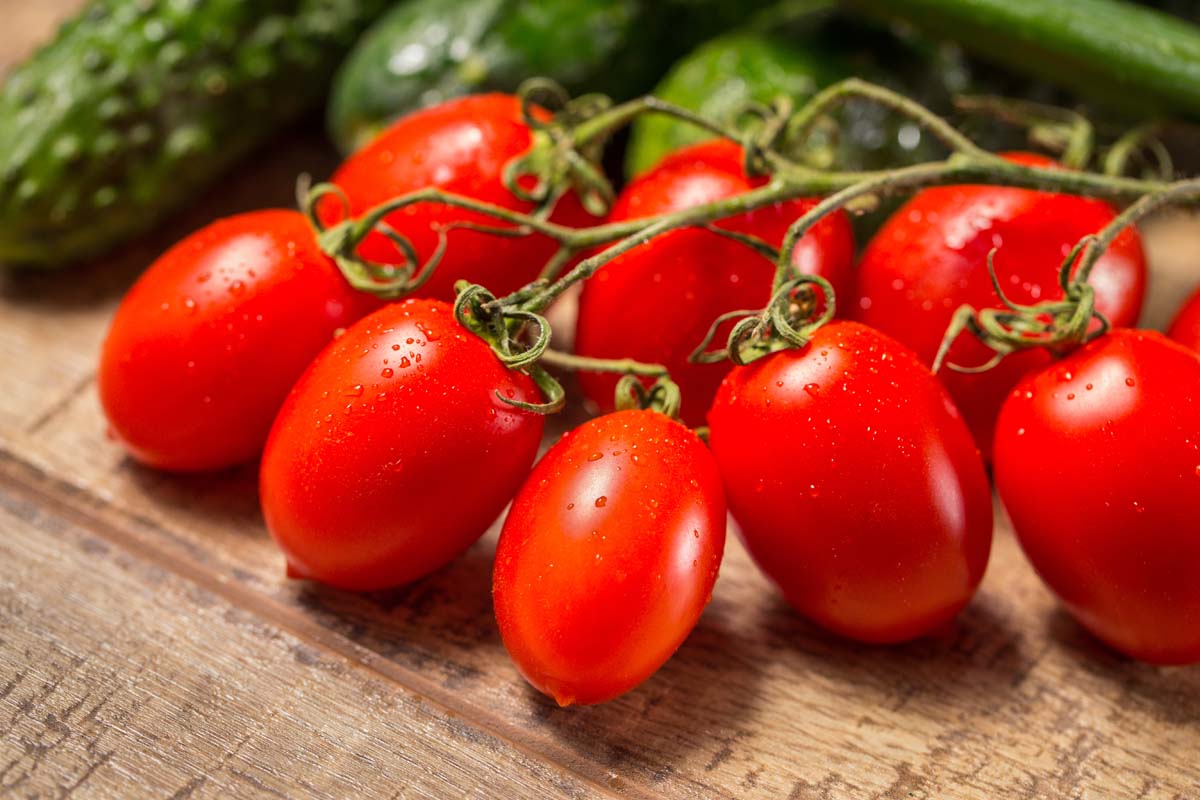
Are you growing ‘Roma’ tomatoes? Drop us a note in the comments below.
And if you want to learn more about different tomato varieties to grow in your garden, check out these guides next:
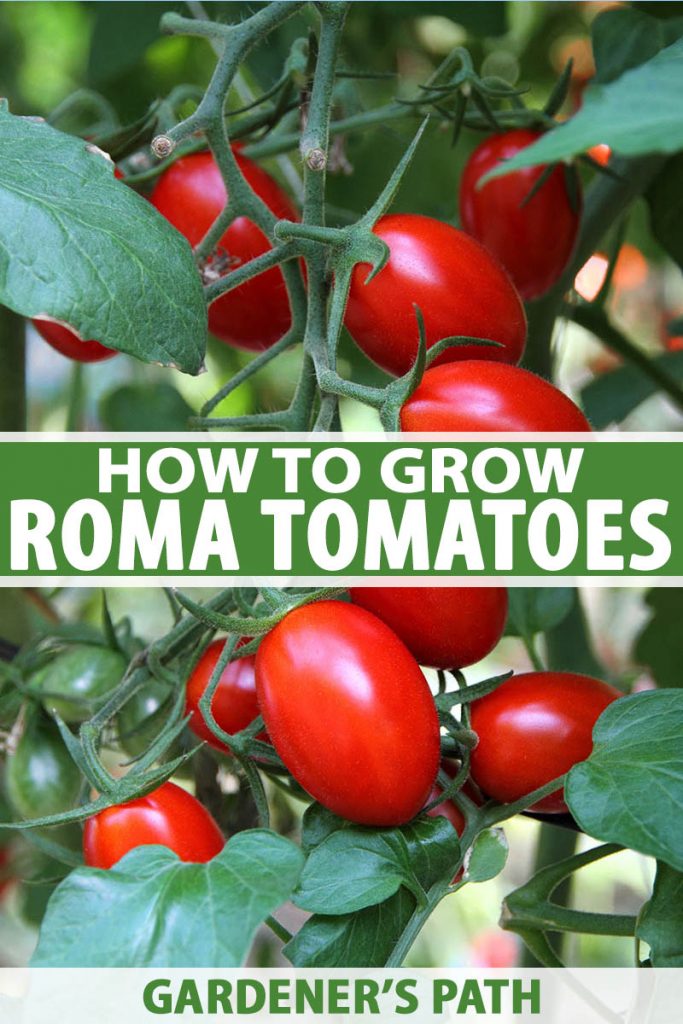
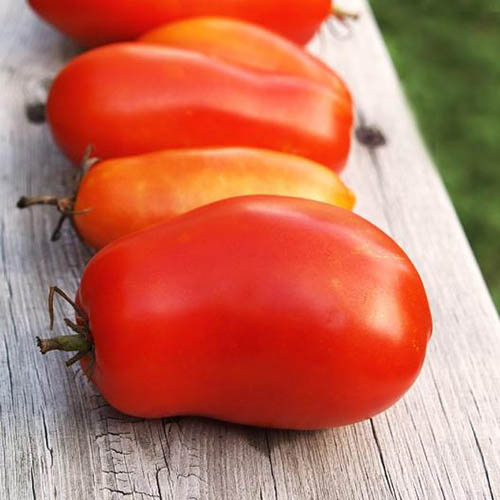
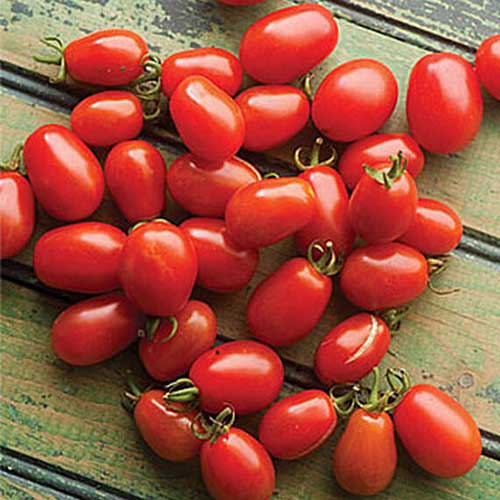

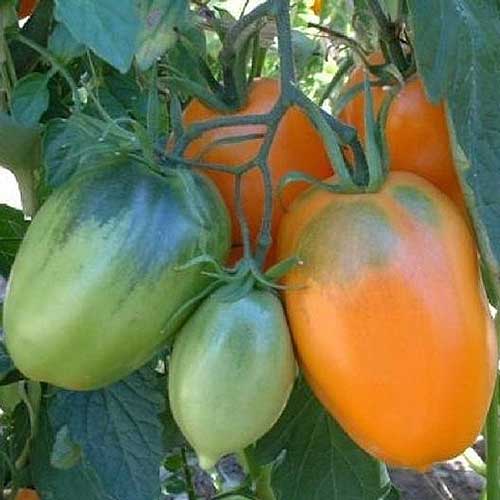
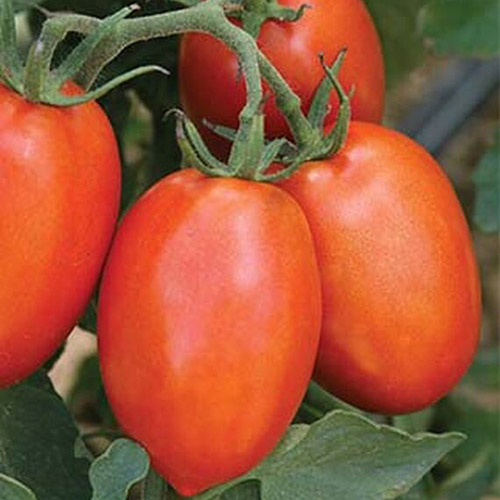
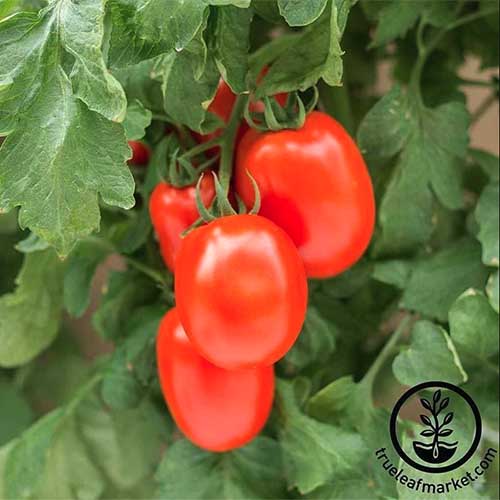
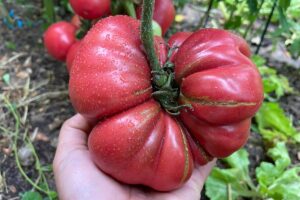
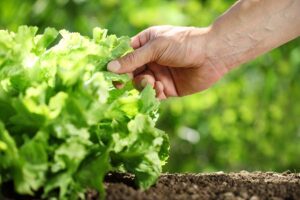
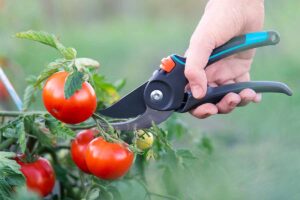
Great information
Thanks Peter!
Should roma’s be washed before they are frozen?
Yes, they should be washed under cool running water first Michael.
But allow them to air dry before freezing to prevent ice crystals from forming. Thanks for asking!
There is no Italian tomato, not even the San Marzano is originally from Italy. All tomatoes came from the New World.
Yes, this is correct- tomatoes are originally from the New World. But the way plants have traveled in cultivation can be fascinating. The origins of a modern cultivar may differ significantly from the native heritage of a given plant. It’s believed that these have crisscrossed the globe, with varieties brought to Italy, developed further and cultivated there, and then brought back to the US in this case, via Italian immigrants in the 1950s.
First time grower